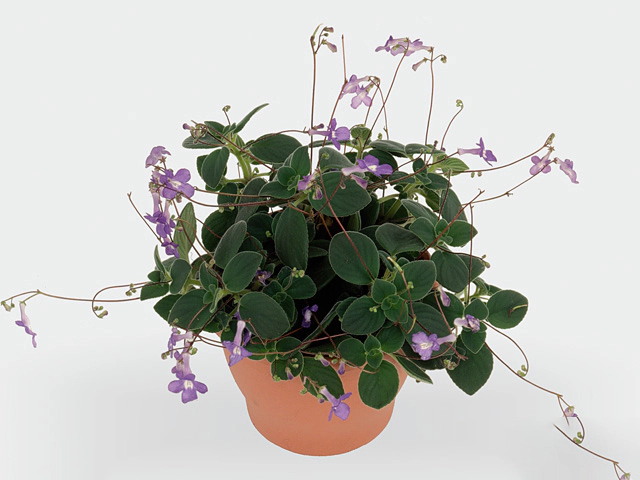Introduction to Streptocarpus saxorum: A Hidden Gem for Houseplant Enthusiasts
Streptocarpus saxorum, also known as the Cape Primrose or the False African Violet, is a charming and delicate plant that brings elegant color and soft texture into indoor spaces. Native to Tanzania and Kenya, this African beauty belongs to the Gesneriaceae family, the same plant group as African violets. With its trailing stems, fuzzy foliage, and continuous display of violet-blue flowers, Streptocarpus saxorum is an ideal choice for hanging baskets, shelves, or windowsills where its blooms can be appreciated up close.
Despite its exotic origins, this plant is surprisingly undemanding and makes a great addition to a beginner’s houseplant collection. With a little attention and the right conditions, Streptocarpus saxorum will reward you with flowers for most of the year. In this article, we’ll explore how to care for this delicate trailing plant, where to display it in your home, and how to keep it thriving for years to come.
Plant Characteristics and Growth Habit
Streptocarpus saxorum distinguishes itself from other houseplants with its gentle appearance and relaxed growth habit. This plant typically features:
- Delicate violet-blue flowers with distinct yellow or white throats, blooming in clusters at the ends of thin, wiry stems.
- Velvety, grey-green leaves that are slightly fleshy and covered in soft hairs.
- Trailing growth habit that makes the plant well-suited to hanging baskets or elevated planters.
- Compact size: Usually growing no more than 20–30 cm in width and height, making it perfect for smaller spaces.
This plant is a frequent bloomer, often producing flowers for 9–10 months of the year under favorable conditions. It is not just showy but also an easy way to add long-lasting florals indoors.
Light Requirements
Streptocarpus saxorum thrives in bright, indirect light. Its native environment beneath the dappled canopies of East African forests suggests it prefers filtered light rather than direct sun exposure. Here’s how to meet its light needs indoors:
- Ideal placement: An east- or north-facing window provides gentle morning light without risk of sunburn.
- Too much sunlight: Harsh western or southern windows, especially during summer, can scorch the leaves. Use a sheer curtain to diffuse direct sun.
- Low-light tolerance: While tolerant of moderate shade, insufficient light will reduce flowering and promote leggy growth.
If your indoor environment lacks natural sunlight, a grow light can supplement and sustain the plant’s flowering cycle during darker months.
Watering and Humidity
Like many members of the Gesneriad family, Streptocarpus saxorum is somewhat drought-tolerant, thanks to its slightly succulent nature. However, it still needs consistent moisture to keep blooming. Follow these simple rules:
- Watering frequency: Let the top inch of soil dry out before watering again. Too much moisture can lead to root and crown rot.
- Avoid wet leaves: Water directly into the soil, not over the foliage, to prevent fungal diseases.
- Humidity levels: Although adaptable, Streptocarpus appreciates moderate humidity (around 50–60%). Low humidity may cause leaf edges to dry out.
- Tip: Grouping it with other plants or placing it on a pebble tray can help boost ambient humidity without stress.
Soil and Potting
This plant requires well-draining, airy soil to avoid waterlogging, which can be fatal. Choose or create a soil mix that supports healthy root development. Recommended options include:
- African violet soil mix: These commercial mixes usually offer the right balance of drainage and moisture retention.
- Custom blend: Combine equal parts peat moss, perlite, and vermiculite or orchid bark for an ideal growing medium.
Ensure the pot used has good drainage holes to minimize the risk of standing water. A shallow and wide container suits the plant’s spreading growth habit best.
Temperature and Fertilizer
Streptocarpus saxorum thrives in room temperatures between 60°F–75°F (15°C–24°C). It is not frost-hardy and should be protected from cold drafts, sudden temperature drops, and excessive heat. During growing seasons (spring through early autumn), regular feeding helps promote continuous flowering.
- Fertilizer schedule: Use a balanced, water-soluble fertilizer diluted to half-strength every 2–4 weeks during the growing season.
- Low-feeding winter: Reduce or eliminate feeding in winter when the plant slows down naturally.
- Tip: Avoid high nitrogen fertilizers, as they may promote leafy growth at the expense of blooms.
Pruning, Maintenance, and Propagation
Keeping your Streptocarpus looking its best takes only a few simple maintenance steps. Proper pruning and occasional propagation can also revitalize older plants.
Pruning
- Remove spent flowers: Pinch off faded blooms to encourage new flower growth and improve appearance.
- Trim leggy stems: Cut back elongated stems lightly to maintain compact, healthy shape.
- Check for pests: Inspect regularly for mealybugs, aphids, and spider mites, especially if humidity is too low.
Propagation Tips
Streptocarpus saxorum is easily propagated by stem cuttings. Here’s how:
- Take a 3–4-inch stem cutting with at least one node.
- Remove the lower leaves and let the cut surface dry for a few hours.
- Plant the cutting in moist, airy potting mix or perlite.
- Cover with a plastic dome or place in a humid environment to encourage rooting.
- Roots typically develop within 3–5 weeks.
Once the cutting is well-rooted, transplant it into a permanent pot and care for it as usual.
Common Problems and How to Avoid Them
Though generally trouble-free, Streptocarpus saxorum can occasionally experience a few issues. Here’s how to troubleshoot common problems:
- Yellowing leaves: Likely due to overwatering or poor drainage. Check roots for rot and reduce watering frequency.
- No flowers: This may be due to insufficient light, too much fertilizer, or natural dormancy. Adjust your care accordingly.
- Wilting leaves: Underwatering or sudden temperature shifts. Keep watering consistent, and avoid placing the plant near heaters or drafty windows.
- Pest infestation: Treat minor infestations with insecticidal soap or neem oil. Improve air circulation to discourage future issues.
Conclusion: Why Streptocarpus saxorum Deserves a Spot in Your Plant Collection
If you’re looking for a unique flowering houseplant that doesn’t demand too much from its caregiver, Streptocarpus saxorum stands out as a beautiful and manageable option. Its cascading growth habit and near-continuous display of soft violet blooms make it a perfect choice for indoor spaces needing a little extra cheer and elegance. Whether you’re an experienced collector or a new gardener, this African gem adapts well to home environments and returns your care with abundant flowers and easygoing charm.
With just a few basic guidelines—proper light, well-draining soil, careful watering, and occasional feeding—you’ll enjoy the vibrant presence of Streptocarpus saxorum year-round. It’s proof that great beauty often comes in small, humble packages.
References
- Hessayon, D. G. (2012). The House Plant Expert. Expert Books.
- Royal Horticultural Society. (2023). Streptocarpus saxorum Growing Guide. Retrieved from https://www.rhs.org.uk
- Missouri Botanical Garden. (2023). Streptocarpus saxorum Profile. Retrieved from https://www.missouribotanicalgarden.org








